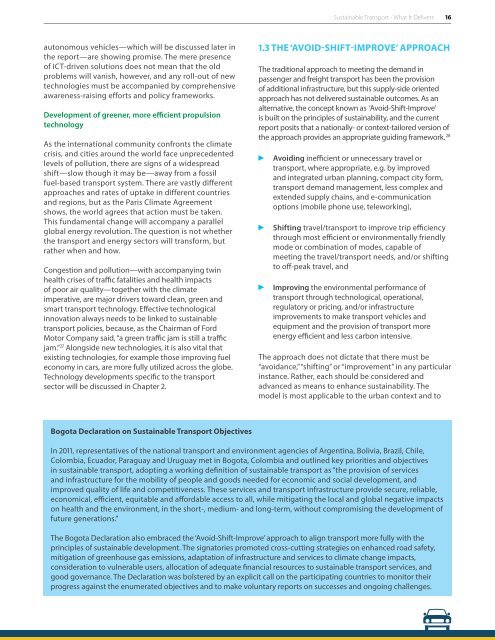MOBILIZING DEVELOPMENT
a5OQ306q56U
a5OQ306q56U
You also want an ePaper? Increase the reach of your titles
YUMPU automatically turns print PDFs into web optimized ePapers that Google loves.
Sustainable Transport - What It Delivers 16<br />
autonomous vehicles—which will be discussed later in<br />
the report—are showing promise. The mere presence<br />
of ICT-driven solutions does not mean that the old<br />
problems will vanish, however, and any roll-out of new<br />
technologies must be accompanied by comprehensive<br />
awareness-raising efforts and policy frameworks.<br />
Development of greener, more efficient propulsion<br />
technology<br />
As the international community confronts the climate<br />
crisis, and cities around the world face unprecedented<br />
levels of pollution, there are signs of a widespread<br />
shift—slow though it may be—away from a fossil<br />
fuel-based transport system. There are vastly different<br />
approaches and rates of uptake in different countries<br />
and regions, but as the Paris Climate Agreement<br />
shows, the world agrees that action must be taken.<br />
This fundamental change will accompany a parallel<br />
global energy revolution. The question is not whether<br />
the transport and energy sectors will transform, but<br />
rather when and how.<br />
Congestion and pollution—with accompanying twin<br />
health crises of traffic fatalities and health impacts<br />
of poor air quality—together with the climate<br />
imperative, are major drivers toward clean, green and<br />
smart transport technology. Effective technological<br />
innovation always needs to be linked to sustainable<br />
transport policies, because, as the Chairman of Ford<br />
Motor Company said, “a green traffic jam is still a traffic<br />
jam.” 27 Alongside new technologies, it is also vital that<br />
existing technologies, for example those improving fuel<br />
economy in cars, are more fully utilized across the globe.<br />
Technology developments specific to the transport<br />
sector will be discussed in Chapter 2.<br />
1.3 THE ‘AVOID-SHIFT-IMPROVE’ APPROACH<br />
The traditional approach to meeting the demand in<br />
passenger and freight transport has been the provision<br />
of additional infrastructure, but this supply-side oriented<br />
approach has not delivered sustainable outcomes. As an<br />
alternative, the concept known as ‘Avoid-Shift-Improve’<br />
is built on the principles of sustainability, and the current<br />
report posits that a nationally- or context-tailored version of<br />
the approach provides an appropriate guiding framework. 28<br />
Avoiding inefficient or unnecessary travel or<br />
transport, where appropriate, e.g. by improved<br />
and integrated urban planning, compact city form,<br />
transport demand management, less complex and<br />
extended supply chains, and e-communication<br />
options (mobile phone use, teleworking),<br />
Shifting travel/transport to improve trip efficiency<br />
through most efficient or environmentally friendly<br />
mode or combination of modes, capable of<br />
meeting the travel/transport needs, and/or shifting<br />
to off-peak travel, and<br />
Improving the environmental performance of<br />
transport through technological, operational,<br />
regulatory or pricing, and/or infrastructure<br />
improvements to make transport vehicles and<br />
equipment and the provision of transport more<br />
energy efficient and less carbon intensive.<br />
The approach does not dictate that there must be<br />
“avoidance,” “shifting” or “improvement” in any particular<br />
instance. Rather, each should be considered and<br />
advanced as means to enhance sustainability. The<br />
model is most applicable to the urban context and to<br />
Bogota Declaration on Sustainable Transport Objectives<br />
In 2011, representatives of the national transport and environment agencies of Argentina, Bolivia, Brazil, Chile,<br />
Colombia, Ecuador, Paraguay and Uruguay met in Bogota, Colombia and outlined key priorities and objectives<br />
in sustainable transport, adopting a working definition of sustainable transport as “the provision of services<br />
and infrastructure for the mobility of people and goods needed for economic and social development, and<br />
improved quality of life and competitiveness. These services and transport infrastructure provide secure, reliable,<br />
economical, efficient, equitable and affordable access to all, while mitigating the local and global negative impacts<br />
on health and the environment, in the short-, medium- and long-term, without compromising the development of<br />
future generations.”<br />
The Bogota Declaration also embraced the ‘Avoid-Shift-Improve’ approach to align transport more fully with the<br />
principles of sustainable development. The signatories promoted cross-cutting strategies on enhanced road safety,<br />
mitigation of greenhouse gas emissions, adaptation of infrastructure and services to climate change impacts,<br />
consideration to vulnerable users, allocation of adequate financial resources to sustainable transport services, and<br />
good governance. The Declaration was bolstered by an explicit call on the participating countries to monitor their<br />
progress against the enumerated objectives and to make voluntary reports on successes and ongoing challenges.


